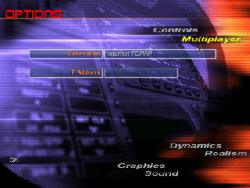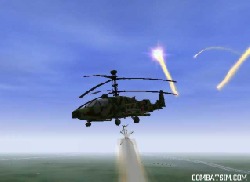Page 4
Multiplayer
The multiplayer aspects of this simulation continue in the theme of total flexibility. Multiple players can join an online game at any time, jump into a host's flight, their own flight, or an enemy flight to fly head-to-head. The bandwidth requirements for campaigns online are fairly heavy. LAN squadrons should have no problems getting several pilots online in a full flown campaign. Internet flyers with broadband connections (cable, ADSL, DSL, ISDN) can fly campaigns online but may be limited to three or four pilots connected to a fast host connection. Those of us with narrow bandwidth connections (33.6 K+ modems) may occasionally get a two-player online campaign in the air. I recommend the Skirmishes for 33.6 or greater modem connections. The Skirmishes are just small-scale wars and can provide four or five hours of online play for two to three people. Low bandwidth (or the bandwidth impaired as I prefer to call us) hosts should remember one important fact: you game must run the same visual as if you were playing offline (assuming that all of you do not play offline with stuttering and pauses). If your game has pauses then everyone should exit the sim all the way to the Main Menu. The host should turn down his graphic settings (the clients can leave them up at their normal offline settings) then restart the Campaign or Skirmish and check for pauses or delayed weapon firing. The load is on the host machine, pick the best connection/most powerful PC for the host.
Fig. 10. Multiplayer Options TCP-IPGetting online via the Internet or a LAN is pretty easy. The host for Internet games just clears the IP address. Clients enter the host's IP. The host chooses a Campaign or Skirmish, then a side (Blue or Red), and generates the Campaign or Skirmish. As soon as the host is at the map screen, the host's callsign appears with the name of the selected Campaign or Skirmish next to it and all clients can join. In online testing we have had the best success if all the clients do not attempt to join at the same time. Since Internet multiplayer sessions will probably involve only three or four pilots at most, this is not onerous.
There is no pause or clock stop available in multiplayer. This changes multiplayer games from solo play. If all players are using a voice communications program like Battle Comm, Roger-Wilco, or TeamSound, the players should look at the situation Map and discuss the Briefings for all the missions available. Clicking on each mission will show briefing information, map waypoints, and mission goals. This is the time to adjust waypoints, discuss strategies, and assign players to specific targets. After everyone agrees on what mission they want to fly, cooperative, different flights, or head-to-head (players that choose opposite sides when they enter the campaign see different map screens naturally). When you are ready, select a mission, a gunship, and adjust your weapons loadout.
Sometimes, if the client and host select the same mission, the client's gunship can sometimes be in the air whether the host has taken off or not because the AI is controlling the client's gunship and the take-off time has passed. If you find yourself in the air, you will note that your autopilot is engaged. The AI needs to get the host and player(s) synchronized before it will turn over control to the client. It may take a few seconds, and there is no point pounding on the Autopilot key during this time. The game will release control when everything is synchronized. Just set your controls near where you see the AI have them set and press the autopilot button every four or five seconds. The Autopilot will never crash your helicopter and every mission so far has had several minutes of safe flight before trouble starts.
Fig. 11. Multiplayer Modem OptionsZero G says: The client may join as soon as the host selects the campaign and sees the map screen. We all get in the game and look for a suitable mission with the right number (and kind) of helicopters. We then decide who will fly what helo (1-1, 1-2, 1-3, etc.) This is important. The player in 1-1 (flight lead) has control of waypoints. If he dies then that control is transferred to the next pilot in numerical sequence (first 1-2 then 1-3, therefore if you choose to fly a co-op four ship mission and choose to fly in 1-1 and 1-3 your flight will loose control of changing waypoints if 1-1 goes down). We fly the mission until we run out of ammo or targets in the area, then back to a FARP to refuel and reload weapons, and perhaps add some waypoints, before we go again. This is generally repeated until all targets in a given area are killed or we are shot down. Then a new flight can be selected and the fun starts all over again. There are plenty of times where human players will take their own flight instead of flying wing so they can control an AI wingman. This says some good things about the changes made to the wingman AI since it is nice to have the extra firepower along when things get busy.
Toggling to the map screen at anytime during a mission is useful and one of the great features of EECH. Not being able to stop the clock in multiplay is one of my bigger frustrations (don't you guys ever have to use the bathroom?). At any time during a mission you can engage the Autopilot, then toggle out to the map screen to examine the situation while the helicopters are ingressing. You can modify waypoints on the fly to keep to the valleys and briefly evaluate the map data.
Enemy Engaged RAH-66 Comanche vs. Ka-52 Hokum cooperates with Battle Comm, Roger-Wilco, Team Sound, and Game Commander. The voice comms are clear with all of them, select 'Use High CPU Priority' in Roger-Wilco. I did not have to make any special entries in any of these online communication programs setup files (often a list of games that require special settings). EECH is very well behaved. Game Commander works perfectly with a keypress duration set at 100 ms.
Fig. 12. Does not look good!Across the top of the map screen are a series selections to provide you with information that is required for your mission and your campaign to be successful. MAP, SIT. REP., LOG, PAYLOAD, Briefing, OPTIONS, and SAVE. MAP increases the map size to fill the briefing inset. SIT. REP. (Situation Report) shows your objectives and your progress towards winning the campaign. LOG is a text listing of all the verbal Intel that is constantly provided in EECH. There is so much radio chatter that a written record is really useful (Enemy aircraft inbound where?). PAYLOAD is only accessible after a mission and a gunship has been selected. Clicking on the loadout can change the weapon on each individual hardpoint. There are also three preconfigured loadouts (Air to Air, Air to Ground, Recon). Clicking on them individually changes the loadouts on each hardpoint. Be sure to leave the out stub wing hardpoints empty if your wish to fly in low observability mode.
Zero G says: A note on using custom weapon loads outs, the fuel load will be dropped on your helo to keep the max weight within allowed limits so be very careful when using a heavy load. Failing your mission because you ran out of fuel is not a good way to win campaigns.
OPTIONS simply takes you to the options screen. SAVE allows campaigns to be saved so you don't have to plan a marathon session to finish one. Another small complaint, you cannot browse your saved games. Be sure you remember the name of your previous saved game because you cannot look it up from within EECH.
On the map, after you have selected a mission, you can adjust waypoints, add waypoints, or delete waypoints. You can not change your mission target or type. However, in a campaign there are literally dozens of missions available at any one time. Here is a hint: When you begin a new campaign, wait several minutes before selecting a mission. The campaign AI really does start with a blank slate. If you can be patient it will generate a broad selection of missions to choose from after the campaign is gets rolling.
Coming Soon: Part 2 EECH has Zero G's evaluation of the flight model and weapons systems. Froglips will wrap up his review of the cockpit and avionics.





